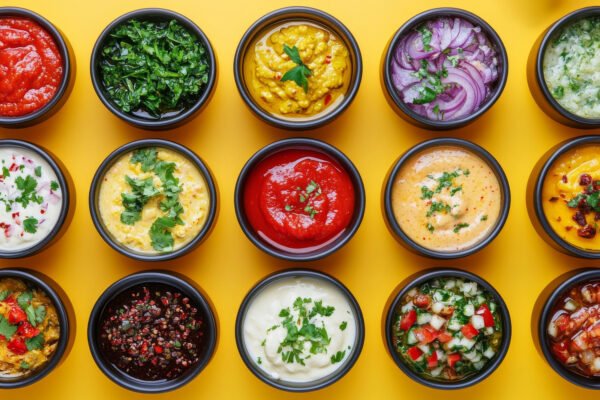Global flavors are reshaping the definition of American cuisine.
From birria to salsa macha to aguachile, cuisines beyond the traditional “big three” (Italian, Mexican, and Chinese) are thriving in restaurants across the country. Nearly half of U.S. consumers (47%) have eaten a globally influenced food in the past week, according to a recent Datassential report, and 70% of operators report increasing customer demand for global flavors. For restaurants, manufacturers, and retailers, understanding this shift isn’t optional — it’s essential.
The Global Flavor Boom: By the Numbers
The evidence is clear: global cuisines are winning in America’s restaurant market.
Datassential’s Restaurant Closures Report shows that globally influenced restaurants are gaining ground even as overall industry closures challenge the broader market. The trend has accelerated dramatically in recent years. In 2017, just 28% of consumers had eaten a globally influenced dish in the past week. Today, that number is 47%—a 68% increase in just eight years.
From 2019 to today, global restaurants have steadily gained market share while many traditional categories have struggled. Asian and South/Central American cuisines are leading this growth, showing the strongest expansion in both new restaurant openings and grocery availability.
Beyond restaurants, consumer access to global foods is widespread. Eighty-eight percent of consumers have a globally influenced restaurant in their area. Seventy-eight percent have access to a global grocer. Fifty-five percent actively choose global foods over other options when dining out. This isn’t a passing trend—it’s infrastructure.
Which Global Foods Are Actually Growing
The fastest-growing global dishes reveal what American consumers want right now: authentic, bold, regionally specific flavors.
Birria
a slow-cooked goat or beef stew from Jalisco, Mexico—has exploded from regional specialty to national phenomenon. You’ll find it on food truck menus, casual QSR concepts, and upscale restaurants. Birria has evolved beyond traditional stews into birria tacos, consommé dips, and even birria pizza.
Salsa macha
a smoky, nutty chile sauce from Veracruz—is finding new life as a condiment and topping. Its complexity works across categories: on eggs, drizzled over avocado, mixed into mayo, or as a finishing sauce for proteins.
Aguachile
a spicier, more vibrant cousin to ceviche from Sinaloa—is gaining momentum as consumers explore ceviche variations and seek bolder flavor profiles.
Even mainstream global cuisines are evolving regionally. Roman cacio e pepe now shares menu space with spaghetti and meatballs. Thai curry variations appear alongside pad Thai. South Indian dosas compete with North Indian butter chicken. Consumers want depth and authenticity, not just a single interpretation of a cuisine.
Beyond these standouts, African and Middle Eastern flavors are gaining traction. Harissa, shawarma, jollof rice, and tagines are becoming familiar to younger diners. Peruvian, Lebanese, and Nigerian cuisines are entering mainstream consciousness through social media, travel, and younger generations’ cultural curiosity.
Why Younger Consumers Are Driving Global Flavor Growth
- Gen Z and Millennials lead the charge in global food exploration—and their reasons go beyond simple novelty-seeking.
- Social media and cultural discovery. Platforms like TikTok and Instagram expose diners to authentic global dishes daily, sparking curiosity and demand. A trending Korean street food video can drive restaurant traffic within weeks.
- Travel and cultural exchange. Younger generations travel more and seek authentic experiences. When they return home, they look for restaurants that recreate those discoveries.
- Global foods as culture and community. Trying global foods isn’t just about taste—it’s about exploring identity, community, and creativity. This psychological driver makes global flavor adoption stickier than trend-chasing alone.
- Accessibility through retail and delivery. Global grocers, ethnic markets, and delivery services have made exploration easier. Seventy-eight percent of consumers have a global grocer nearby. This removes the barrier to experimentation.
Global Flavors Command Premium Positioning
Operators aren’t just seeing volume growth—they’re seeing margin growth. Seventy-four percent of operators say globally influenced dishes can command higher prices. Consumers perceive global foods as premium and are willing to pay accordingly.
This opens opportunity for:
- Full-service restaurants introducing globally inspired tasting menus
- Fast-casual concepts building identity around a specific cuisine
- QSR chains testing limited-time global offerings
- Retailers featuring global ingredients and prepared foods with premium pricing
The Challenge: Authenticity Meets Approachability
Despite strong growth, operators cite clear barriers to capitalizing on global flavor trends.
Forty-nine percent of operators identify staff training as their top challenge. Preparing global dishes correctly—sourcing authentic ingredients, understanding flavor balance, respecting regional traditions—requires expertise many teams lack. This gap creates inconsistency and undermines consumer trust.
Seventy-six percent of consumers say detailed menu descriptions matter when trying unfamiliar foods. Vague descriptions (“Asian noodle bowl”) lead to skepticism. Clear, specific descriptions (“Hand-pulled Vietnamese bánh mì with house-cured pork, pickled vegetables, and cilantro mayo”) build confidence and increase trial.
The tension is real: global flavors need authenticity to feel credible, but accessibility to reach mainstream audiences. Successful operators are mastering both.
How Restaurants Can Capitalize on Global Flavor Growth
Start small and strategic. Introduce globally inspired sauces, marinades, or sides before committing to full menu overhauls. A signature global sauce can reinvigorate existing menu items and test consumer interest with lower risk.
Train teams on authentic preparation. Invest in staff education on global ingredients, techniques, and flavor profiles. This builds consistency, improves execution, and gives teams confidence when describing dishes to guests.
Write detailed, specific menu descriptions. Replace vague language with clarity. Instead of “spicy Asian sauce,” write “harissa-chile oil from Tunisia.” This specificity builds credibility and reduces hesitation among adventurous diners.
Source authentically but communicate approachability. Highlight when you’re using traditional techniques or authentic ingredients, but frame them in accessible language. “Slow-cooked for 8 hours, just like in Jalisco” is more compelling than just “birria.”
Rotate global offerings seasonally or as LTOs. Test new global flavors as limited-time offerings before permanent menu integration. This keeps menus fresh, manages sourcing complexity, and tests consumer demand.
Frequently Asked Questions About Global Flavors and Foods
What exactly are “global flavors”?
Global flavors refer to foods and ingredients influenced by cuisines outside of mainstream Italian, Mexican, and Chinese fare — such as Indian, Thai, Peruvian, Lebanese, Nigerian, Vietnamese, or Korean. These foods bring authentic techniques, ingredients, and traditions from regions around the world to American tables. Global flavors span both restaurant dishes and retail ingredients that consumers use at home.
Which global foods and cuisines are growing fastest in the U.S.?
Asian cuisines (Vietnamese, Thai, Korean, Filipino) and South/Central American cuisines (Peruvian, Colombian) are leading growth. Specific dishes like birria, aguachile, salsa macha, and bulgogi are among the fastest-growing. African and Middle Eastern flavors—including harissa, shawarma, jollof rice, and tagines — are also gaining popularity, especially among Gen Z and Millennial diners.
Why are global flavors trending now more than ever?
Multiple factors are converging: social media (TikTok, Instagram) exposes diners to global dishes daily; younger generations travel more and seek authentic dining experiences; global grocers and ethnic markets make ingredients accessible (78% of consumers have one nearby); and delivery services remove friction from trying new cuisines. Global foods are also increasingly seen as premium and culturally significant, not just novelty.
Are global flavors replacing traditional American cuisine?
Not replacing—blending. Many “American” dishes now incorporate global elements, creating fusion menus that combine comfort and adventure. Think Korean BBQ tacos, Peruvian chicken sandwiches, or Thai-inspired hot wings. What’s considered “global” today could become tomorrow’s American classic, just as pizza and tacos did decades ago.
How much of the U.S. has access to global restaurants and ingredients?
Access is remarkably high. Eighty-eight percent of U.S. consumers live near a globally influenced restaurant. Seventy-eight percent have access to a global grocer or ethnic market. This widespread infrastructure means global food exploration is no longer geographically limited to major metros — it’s available coast to coast.
What percentage of consumers actively choose global foods?
Fifty-five percent of consumers often choose global foods over other menu options when dining out. Forty-seven percent have eaten a globally influenced dish in the past week. This represents significant mainstream adoption, not niche interest. For context, only 28% of consumers ate global foods weekly in 2017 — a 68% increase in eight years.
Can restaurants charge premium prices for global food dishes?
Yes. Seventy-four percent of operators report that globally influenced dishes can command higher price points than traditional offerings. Consumers perceive global foods as premium and are willing to pay accordingly, especially when dishes are positioned as authentic and prepared with care.
What’s the biggest challenge operators face with global flavors?
Staff training is the top barrier—49% of operators cite it as their primary challenge. Preparing global dishes correctly requires understanding authentic ingredients, flavor balance, regional techniques, and sourcing. Inconsistent execution undermines consumer trust. Addressing this through training and clear recipe standards is critical.
How important are menu descriptions when introducing global foods?
Very important. Seventy-six percent of consumers say detailed menu descriptions matter when trying unfamiliar dishes. Vague descriptions create skepticism and reduce trial. Specific, clear descriptions (“Hand-pulled Vietnamese bánh mì with house-cured pork, pickled vegetables, and cilantro mayo”) build confidence and increase sales of global items.
How can manufacturers and retailers capitalize on global flavor growth?
Manufacturers should develop globally inspired products aligned with fast-growing cuisines (Vietnamese, Peruvian, Korean, Lebanese). Retailers should feature global ingredients and prepared foods with premium positioning and authentic sourcing stories. Both should align launches with seasonal peaks and social media momentum—timing matters.
Is global flavor growth different across age groups?
Yes. Gen Z and Millennials lead global food exploration and adoption. Younger consumers are more curious, more influenced by social media, and more likely to view global foods as cultural exploration rather than trend-chasing. However, global flavor adoption is growing across all age groups, indicating this is moving beyond youth trend to mainstream shift.
Can a restaurant introduce too many global flavors at once?
Yes. Starting small and strategic is better. Introduce globally inspired sauces, marinades, or sides before committing to full menu overhauls. Test global offerings as limited-time items before permanent integration. This approach reduces operational complexity, manages sourcing challenges, and tests consumer demand with lower risk.
The Bottom Line: Global Flavors Are the New American Standard
Global flavors aren’t a trend — they’re a structural shift in how Americans eat. What once was considered exotic is now everyday. What once required travel to experience is now available on every block.
For operators, this means opportunity: introduce global dishes with authenticity and clear descriptions, train teams to execute with care, and leverage limited-time offerings to test demand. For manufacturers and retailers, it means developing products aligned with fast-growing cuisines and positioning them as premium.
The restaurants thriving in 2025 aren’t choosing between authenticity and approachability — they’re mastering both. That balance is the future of American dining.
Track which global flavors and cuisines are gaining momentum in your market. Find out more or book a demo today.
 EN | English UK
EN | English UK DE | Deutsch
DE | Deutsch FR | Français
FR | Français IT | Italiano
IT | Italiano SP | Español
SP | Español





